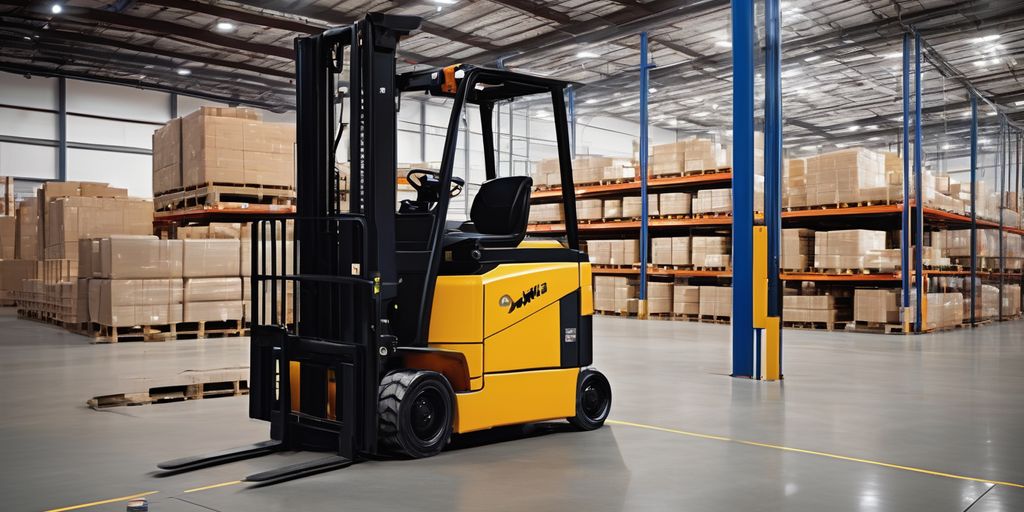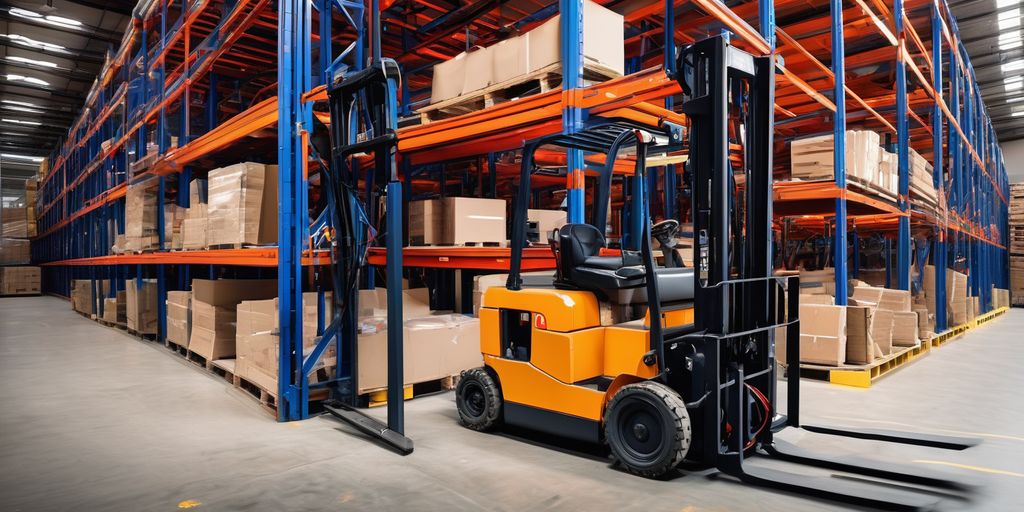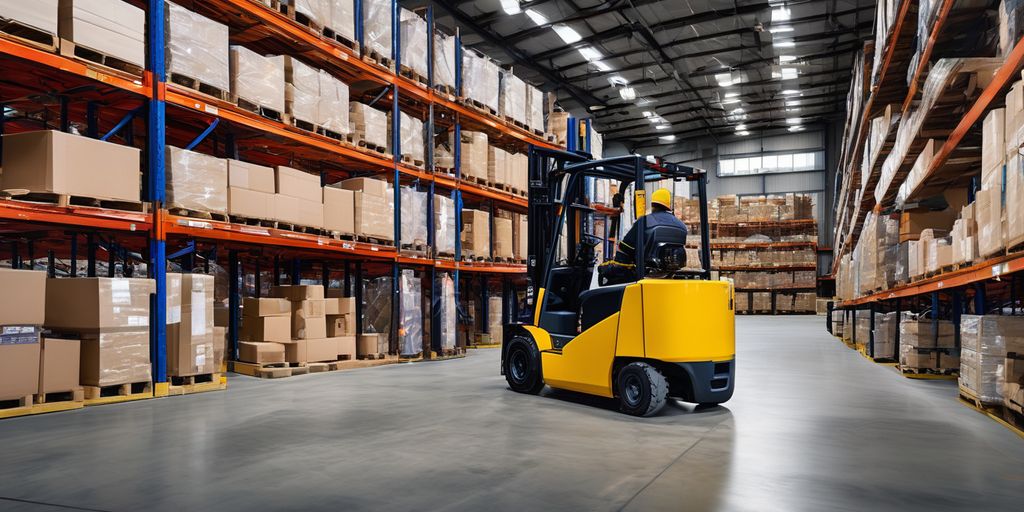Warehouse safety is a critical concern for companies aiming to protect their employees and maintain efficient operations. One of the most significant advancements in this area is the implementation of forklift pedestrian detection systems. These systems utilize cutting-edge technologies such as sensors, cameras, and AI to alert both forklift operators and pedestrians of potential hazards, thereby minimizing the risk of accidents. This article will delve into various aspects of forklift pedestrian detection systems, including their components, the role of OSHA, training programs, technological advancements, benefits and challenges, case studies, and best practices for enhancing safety.
Key Takeaways
- Forklift pedestrian detection systems use sensors, cameras, and AI to enhance safety by alerting operators and pedestrians of potential hazards.
- Adhering to OSHA regulations and standards is crucial for companies to ensure a safe working environment in warehouses.
- Continuous training and education for both forklift operators and pedestrians are essential for maintaining high safety standards.
- Technological advancements such as AI and IoT integration are driving the effectiveness of forklift pedestrian detection systems.
- Implementing these detection systems can significantly enhance safety measures and operational efficiency, despite some potential limitations.
Understanding Forklift Pedestrian Detection Systems

Forklift pedestrian detection systems are essential for enhancing safety in warehouse environments. These systems are specifically designed to detect pedestrians in the vicinity of forklifts, significantly reducing the risk of accidents. By leveraging cutting-edge technologies such as AI and IoT, they provide real-time alerts to both operators and pedestrians, ensuring a safer workplace.
Components and Technology
The core components of forklift pedestrian detection systems include sensors, cameras, and sometimes AI algorithms. These elements work together to monitor the surroundings and identify potential hazards. The sensors can range from ultrasonic to infrared, and even radar, each offering unique advantages in different scenarios.
How They Work
These systems utilize a combination of sensors and cameras to detect pedestrians near forklifts. When a pedestrian is detected, the system triggers alarms to warn both the operator and the pedestrian. In some advanced systems, the forklift may automatically slow down or stop to prevent a collision.
Types of Detection Systems
There are various types of forklift pedestrian detection systems available, each with its own set of features:
- Proximity Sensors: These sensors detect objects within a certain range and are often used to trigger alarms.
- Camera-Based Systems: These systems use cameras to provide visual alerts and can be integrated with AI for enhanced detection capabilities.
- Hybrid Systems: Combining both sensors and cameras, these systems offer a comprehensive solution for pedestrian detection.
Implementing a forklift pedestrian detection system is one of the cornerstones of pedestrian safety. Leveraging cutting-edge technologies such as AI & IoT, these systems help detect pedestrians close to forklifts with cameras and sensors.
The Role of OSHA in Forklift Pedestrian Safety

OSHA Regulations
Understanding OSHA regulations for forklift operations is essential for workplace safety. OSHA (The Occupational Safety and Health Administration) is the foundation that provides training, education, and assistance to companies to promote a safe and healthy work environment. Recognizing that establishing these safety systems is essential, OSHA set strict standards for forklift operations and pedestrian safety.
Compliance Requirements
Compliance with OSHA standards, training, and maintenance are key for preventing accidents and ensuring efficiency. Companies must adhere to these regulations to create a safe working environment. This includes regular safety audits, proper signage, and the implementation of safety protocols.
Impact on Warehouse Safety
Adhering to safety standards is not just a regulatory formality but a crucial aspect of ensuring a harmonious work environment. The standards set by bodies like OSHA provide a framework for safe interactions between forklifts and pedestrians. This significantly reduces the risk of accidents and near-miss cases, promoting overall warehouse safety.
Establishing a forklift pedestrian safety system that protects forklift operators and the pedestrian workers around them is vital.
Training and Education for Forklift Operators and Pedestrians

Importance of Safety Training
Forklift pedestrian safety training covers necessary forklift training for operators and training the workforce to establish a safety culture and raise awareness. It is possible to avert hazardous collisions by educating employees on understanding blind spots, recognizing potential hazards, and adhering to safety protocols.
Lack of training is one of the main reasons for forklift pedestrian collisions. All of the forklift operators must go through necessary forklift training, and they should be certified to operate a forklift. However, more is needed to reach a safe work environment. It is also crucial that pedestrians go through special training underlining the necessary safety precautions.
Training Programs
We provide personalized training programs for forklift operators, technicians, and pedestrians to optimize the security and efficiency of your operations. These programs help prevent misunderstandings between forklift operators and pedestrians.
Continuous Education
Building a culture of safety within industrial environments starts with comprehensive training and awareness programs. These programs are essential in educating both forklift operators and pedestrians about the potential hazards and best practices for safety. Key components of these programs include:
- Regular and comprehensive training for all staff members, emphasizing the risks associated with forklift operations and pedestrian safety.
- Utilizing technology like proximity sensors and pedestrian detection systems to enhance safety measures.
- Continuous evaluation and updating of training materials to reflect the latest safety standards and technological advancements.
Technological Advancements in Forklift Pedestrian Safety

AI and IoT Integration
The integration of advanced technology, especially AI-driven systems, is revolutionizing forklift-pedestrian safety. AI cameras and sensors provide real-time data, enabling collision alerts and gathering information to identify risky behaviors and environmental factors. This technology-driven approach has the potential to significantly reduce pedestrian accidents.
Sensor Technologies
New technologies are improving workplace safety. Cameras provide forklift operators with increased visibility, while LEDs alert pedestrians of a forklift’s presence in noisy environments. Sensors aggregate safety data, allowing managers to address problems before they result in injuries or fatalities. These advancements offer an additional layer of protection and enhance the overall safety of forklift operations.
Real-Time Monitoring
Real-time monitoring systems are a key component of modern forklift-pedestrian safety solutions. These systems enable continuous tracking of both forklifts and pedestrians, ensuring immediate response to potential hazards. The impact of these technologies is significant, offering enhanced safety measures and operational efficiency.
Benefits and Challenges of Implementing Detection Systems

Enhanced Safety Measures
Forklift pedestrian detection systems provide an additional layer of protection for pedestrians, significantly reducing the risk of accidents. These systems heighten operator awareness, especially in areas with limited visibility. Many systems also collect data that can be analyzed to further improve workplace safety protocols.
Operational Efficiency
Implementing detection systems can lead to improved operational efficiency. By preventing pedestrian collisions and improving operator health, these systems optimize overall warehouse operations. Benefits include communication enhancement, productivity increase, and asset life extension. Future trends may involve autonomous forklifts and IoT integration.
Potential Limitations
However, there are limitations to consider:
- Dependence on Technology: Over-reliance on technology may lead to complacency among operators and pedestrians.
- Environmental Constraints: These systems may be less effective in environments with extreme temperatures, dust, or moisture.
- Initial Investment and Maintenance Costs: The cost of installing and maintaining these systems can be significant, especially for smaller operations.
By understanding the benefits and limitations, as well as learning from successful implementations, businesses can make informed decisions about integrating these systems into their safety protocols.
Case Studies of Successful Implementation

Examining real-world applications of these systems provides valuable insights:
Best Practices for Enhancing Forklift Pedestrian Safety

Establishing and adhering to safety protocols is crucial for preventing accidents between forklifts and pedestrians. These protocols should include clear guidelines on pedestrian walkways, forklift operating zones, and right-of-way rules. Regularly updating these protocols ensures they remain effective and relevant.
Regular Maintenance
Conducting regular maintenance on forklifts and pedestrian detection systems is essential for ensuring their optimal performance. This includes daily equipment inspections, timely repairs, and routine checks of safety features. A well-maintained system reduces the risk of malfunctions that could lead to accidents.
Employee Involvement
Engaging employees in safety initiatives fosters a culture of safety within the workplace. Encourage employees to participate in safety training programs, report potential hazards, and provide feedback on existing safety measures. Employee involvement is key to identifying and addressing safety concerns promptly.
By implementing these best practices, businesses can create a safer, more productive working environment where forklifts and pedestrians can coexist harmoniously.
Conclusion
In conclusion, the integration of forklift pedestrian detection systems is a pivotal step towards enhancing warehouse safety. By leveraging advanced technologies such as AI, IoT, and various sensors, these systems proactively mitigate risks and prevent accidents. They not only provide real-time alerts to both forklift operators and pedestrians but also ensure compliance with OSHA's safety regulations. As the industry continues to prioritize the well-being of its workforce, the adoption of these detection systems underscores a commitment to creating a safer and more secure work environment. Ultimately, the benefits of implementing such comprehensive safety measures far outweigh the limitations, making them an indispensable component of modern warehouse operations.
Frequently Asked Questions
What are forklift pedestrian detection systems?
Forklift pedestrian detection systems utilize a combination of sensors, cameras, and sometimes AI to alert forklift operators of pedestrians in their vicinity, thereby preventing potential accidents.
How do forklift pedestrian safety sensors work?
These sensors detect pedestrians in the forklift's path using technologies such as ultrasonic, infrared, laser, or radar sensors. They trigger alarms to warn both pedestrians and operators, and in some cases, automatically slow down the forklift.
Why is it important to adhere to OSHA regulations for forklift pedestrian safety?
Adhering to OSHA's safety regulations and standards helps companies create a safer work environment, minimizing risks and ensuring compliance with legal requirements.
What are the benefits of implementing forklift pedestrian detection systems?
The benefits include enhanced safety for pedestrians, reduced risk of accidents, improved operational efficiency, and the ability to monitor and address safety issues proactively.
How can training programs improve forklift pedestrian safety?
Safety training programs educate both forklift operators and pedestrians on best practices, safety protocols, and the importance of staying vigilant, thereby reducing the likelihood of accidents.
What technological advancements are being made in forklift pedestrian safety?
Recent advancements include the integration of AI and IoT, improved sensor technologies, and real-time monitoring systems that provide increased visibility and proactive safety measures.




Leave a comment
This site is protected by hCaptcha and the hCaptcha Privacy Policy and Terms of Service apply.